Best gaming keyboards in 2024
The best gaming keyboards have it all: style, ergonomics, and of course, the most satisfying clickity clacks.
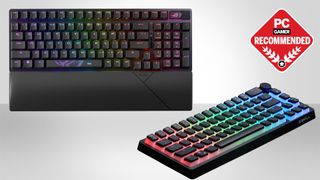
⌨️ The list in brief
1. Best overall
2. Best budget
3. Best wireless
4. Best budget wireless
5. Best compact
6. Best high-end
7. Best competitive
8. Best analog
9. Best ergonomic
10. Best membrane
11. How we test
12. Also tested
13. How to spot the best deal
14. Glossary
When searching for the best gaming keyboard we keep an eye out for features, feel and value for money. Each of the gaming keyboards in this guide deliver on these three points, though we've focused on various price points to cater for any sort of budget.
The best gaming keyboard right now is the Asus ROG Strix Scope II 96 Wireless. It excels in every aspect—superb mechanical feel and a full-size yet compact design. But if you want to go for something cheaper, we've been absolutely blown away by the G.Skill KM250 RGB, which is easily the best budget gaming keyboard in 2024.
One vital aspect of any gaming keyboard purchase is whether to pick a mechanical keyboard. Generally, we'd say it's always worthwhile considering a mechanical switch over a membrane one. They feel much better for typing and gaming and they're generally quicker. Nowadays, you don't even have to spend loads to grab a great mechanical keyboard, with the best cheap gaming keyboards for those who want performance for not a lot of cash.

There are few keyboard enthusiasts as enthusiastic as our Jacob. He's been professionally testing for many years now, and has been collecting mechanical key switches like Smaug hoarded gold for years before that. Whether it's Hall effect or straight mechanical, he's poked and prodded more keyboards and switches than any one man should, and is our expert on all things keeb.
The quick list
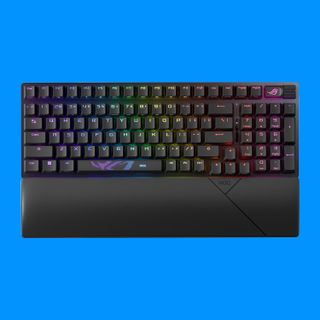
The best overall
The Strix Scope II 96 may have a ridiculous name but it's still a dream to game and type on. Silky smooth switches and clever media keys make this the best gaming keyboard right now.
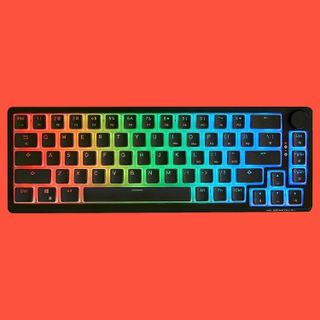
The best budget
The KM250 is an outstanding entry-level gaming keyboard, with the versatility to become almost an enthusiast typing board for less than the price of the cheapest barebones kit.
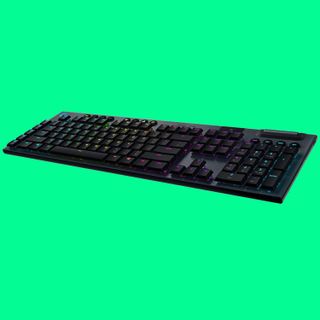
The best wireless
The Logitech G915 is a dream to type on. It comes with low profile keys for a comfortable wrist angle, and that makes all the difference. A favorite among PC Gamer staff, this is a wireless keyboard to be envied.
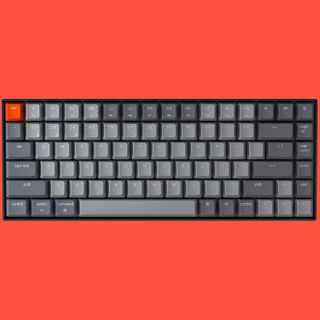
The best budget wireless
A handy entry-level mechanical board with a good build and set of features. The Keychron manages to deliver wireless connectivity for a fraction of the price of most others.
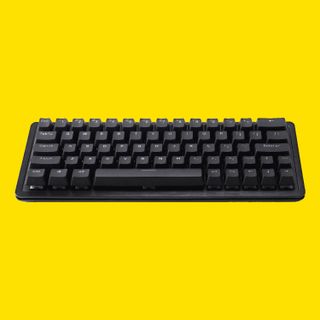
The best compact
Mountain has taken all it's learnt from its first keyboards and created the best-feeling, most usable 60% gaming keyboard I've ever used. It's solid, reliable, responsive, and offers the best typing experience around.
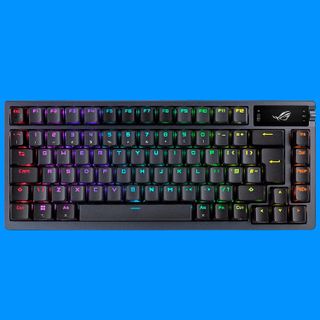
The best high-end
The ROG Azoth is easily Asus' best ever gaming keyboard, and one of the best enthusiast boards. But it's over $100 more than the Mountain Everest 60's full numpad package, which makes it a strictly high-end purchase.
⬇️ Click to load more of the best gaming keyboards ⬇️
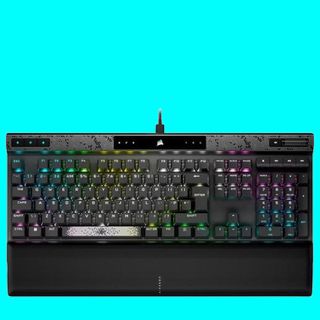
The best competitive
What makes a gaming keyboard great for competitive gaming? Speedy switches and an even quicker polling rate. The Corsair K70 Max offers both, and that's why it's our pick for this spot.
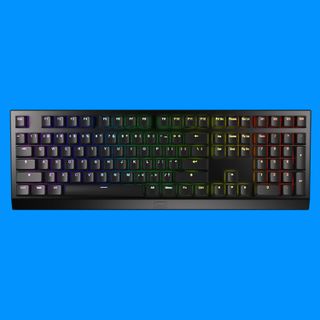
The best analog
The Wooting Two HE uses the magic of magnets to deliver a gaming keyboard like no other. There's a whole bunch of flexibility here, a great app, and superb build quality. So yes, I'm absolutely a fan.
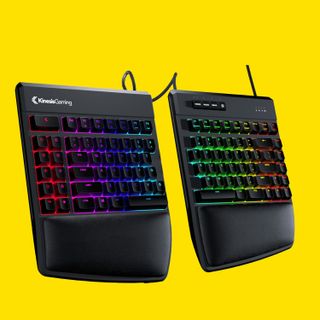
The best ergonomic
If you want to prioritise your health and posture while typing, you'd better opt for an ergo board. Luckily, that doesn't mean sacrificing any important gaming features, thanks to the Kinesis Freestyle Edge RGB's blend of both.
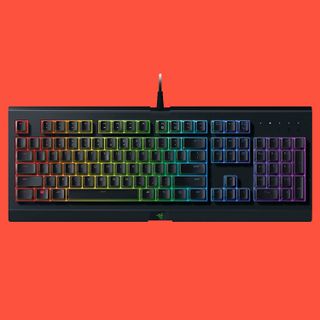
The best membrane
If instead of a mechanical board you prefer the squishy flaoom of a membrane, this is for you. It's a solid, no-frills, nice-looking keyboard that's the best membrane option we've tested.
Recent updates
This guide was updated on March 8 to include the new category, the best ergonomic gaming keyboard, which goes to the Kinesis Freestyle Edge RGB.
The best gaming keyboard






Specifications
Reasons to buy
Reasons to avoid
✅ You want the smoothest typing experience: With lubed switches out of the box you don't need to waste any energy with a pot of lube and a paint brush in order to get an immaculate typing experience.
✅ You want the best generalist gaming keyboard: You can find faster keyboards, and definitely flashier ones, but the ROG Strix Scope II 96 is by far the best generalist board and excels at a lot.
❌ You want speed or analog features: As fast as most other mechanical keyboards, nowadays you can find faster keyboards than this using Hall effect or optical switches.
The best gaming keyboard is the Asus ROG Strix Scope II 96 Wireless, and it's rare that a keyboard is such an all-round joy to use as this is. There are faster, smarter, even cheaper boards—you'll find all of those recommendations below—but the Strix Scope II 96 Wireless brings together many of the features we're looking for in a modern gaming keyboard.
Firstly, some of the smoothest mechanical switches in the biz. You can pick between ROG-branded NX Snow or NX Storm switches in this board. I've been using the Snow switches, which are your regular linear dealio with an actuation force of 45g, though the Storm switches are a moderately heavier tactile option. These switches alone aren't anything special, but a little lube goes a long way.
Not one of the usual things we'd find on a gaming keyboard, but a drop of lube on every mechanical key switch makes a surprising amount of difference to the typing experience. Each key press is smooth, consistent, and every thwack produces a glorious clack.
Both of the available switches actuate at 1.8mm, which is pretty snappy, though not quite as snappy as the Corsair K70 Max at its lowest adjustable actuation point of 0.4mm. Similarly, the Strix Scope's polling rate is a mere 1000Hz—slower than the K70 Max at 8000Hz. Not that I noticed that in-game—the Scope II 96 feels extremely responsive.
It's also relatively quiet. The sound of the linear switches reduced to a light pitter-patter by the sound dampening foam, sturdy PBT plastic keycaps, and switch pads. Lubed up, sturdy stabilisers also keep the larger keys, namely the spacebar, quiet.
You are able to swap out any of the NX Snow switches on this keyboard for keys of your choosing. However, if you don't replace them with lubed switches I will personally hunt you down. Don't do the Scope II dirty like that.
The Scope II 96 is nearly a full-size board—it importantly retains a full numpad—though it's been squished down into a more compact chassis. As a result, the delete key is further away from your pinky than normal. It takes some getting used to, but I've been tapping away on it for a couple of weeks now and I feel I've got typing on the Scope II 96 down to a fine art.
Still, it's been a long time since I've been blown away by a gaming keyboard—so many seemed carbon copies of what Corsair did 10 years ago—but the Scope II 96 is mighty impressive. It focuses on nailing the actual mechanics of a mechanical gaming keyboard. Importantly, it's also great for gaming and doesn't cost anywhere near as much as its smaller, more premium sibling, the ROG Azoth.
Read our full Asus ROG Strix Scope II 96 Wireless review.
The best budget gaming keyboard







Specifications
Reasons to buy
Reasons to avoid
✅ You're looking for the best on a tight budget: With features galore and many unexpected additions for this sort of price tag, we've not seen anything better for less.
❌ You want the best typing experience out of the box: Without some of the more high-end materials in used in the casing of this keyboard, the typing experience can be a little hollow.
Mechanical gaming keyboards can cost a fortune. The G.Skill KM250 RGB's best skill is that it doesn't. It's nowhere close to costing a fortune, yet it still offers mechanical switches, per-key RGB, hot-swappable keys, and discrete media controls.
The G.Skill KM250 redefines what it means to be a budget gaming keyboard. Features that were once enthusiast only are right here, for just $40. During a time when PC peripheral prices generally appear to only be increasing, that's important.
If you're after a good compact board you honestly don't need more than what's being offered here. A simple and small frame with Kailh linear mechanical switches, it's a no-nonsense design if ever there was one. Though you'll be pleased to know that it retains one fan-favorite feature: per-key RGB backlighting.
If you prefer you can jam in some higher-end switches and create a lovely little semi-custom build inside the G.Skill KM250 chassis. It is obviously lacking the high-end luxury of sound dampening and super-fancy stabilisers, but those are compromises I'm willing to make for such a supremely cheap keyboard. And honestly, I've experienced far worse stabilisers on expensive NZXT and Razer keyboards in the past.
The included Kailh switches are not bad, but definitely not great and, combined with the plastic chassis you do end up with quite a hollow-sounding typing experience.
But, having changed out the linear Kailh Red switches for a set of Halo True heavy tactile switches, the difference in the sound is clear. It's not the ultra rich-sounding experience of using the Mountain Everest 60 or Asus ROG Azoth, but it now feels great to type on, dampening or no. It's also at most half the price if you include fancy new switches, and if you've got a headset on you'd be hard pressed to feel the difference.
The board layout itself is pretty standard 65%, which makes for a few more useful keys than a 60%. There's a little bit of spacing between the bulk of the keys and the cursors, and you also get separate Del, PgUp, and PgDn buttons, too. A neat selection.
And a discrete volume wheel. I love a physical, tactile volume control, and it's a genuinely lovely little extra I wouldn't have expected on such an affordable board. It's not just volume up and down, as there's a click down to it which will mute or unmute your machine as well.
I'm honestly genuinely impressed with the package as a whole, and if you want a proper mechanical keyboard experience without paying enthusiast money, the G.Skill KM250 is an outstanding option.
Read our full G.Skill KM250 RGB review.
The best wireless gaming keyboard


Specifications
Reasons to buy
Reasons to avoid
✅ You want a low-profile keyboard: I've tried many low-profile keyboards over the years and I'm yet to match the low-profile clicky switch used on the G915 for satisfying response.
❌ You want to use custom keycaps: The G915 doesn't use standard Cherry MX style stems (cross), and as such you can't fit regular caps onto it.
The Logitech G915 is the best wireless gaming keyboard, but let's not entirely ignore that our number one pick, the Asus ROG Strix Scope II 96, which is also wireless and absolutely worth considering. But we're talking about the G915 here, and it's a familiar sight for yours truly—I've been using it for my past 100,000 words or so.
With Logitech's excellent Lightspeed wireless technology behind it, I've never run into any issues with the wireless connection on this board. It's snappy and responsive as any wired model on the desktop, and you can expect the same performance out of it while you're lazing on the sofa. I also use it frequently when I'm using my sim racing setup—being able to jump onto the keyboard at a moment's notice helps navigating some of the finicky in-game menus in some racing games.
When I'm not using the board as my daily driver, I'm employing it as my handy wireless keyboard for the PC Gamer test bench. Always within reach, no cables to fuss with, and ready in a pinch.
The benefit to a wireless gaming keyboard might not be as pronounced as a wireless gaming headset or similar, but it's definitely handy to have the option to take your board off the desktop on occasion. Luckily, the G915 also excels in other ways to make it even more convincing.
I love a clicky switch, and the G915 is available with low-profile clicky switches that sounds great and are super responsive. That initially came as a bit of a surprise, as the first wave of truly mechanical low-profile switches kinda sucked. These don't, however, and my many hours using this keyboard for writing stories over a span of a couple of years should attest to that. I'd go as far to say this is the best low-profile gaming keyboard I've used to date, too.
As with most Logitech gear, the G915 has a sleek design. It's made up of mostly a top plate of brushed metal, though the underside is a black plastic. The keycaps are ABS plastic and mine are a bit shiny now after years of use. The downside here being once these keycaps break it might be trickier to get a replacement versus a more traditional Cherry switch stem.
Read our full Logitech G915 TKL review (that's the slightly smaller version).
The best budget wireless gaming keyboard






Specifications
Reasons to buy
Reasons to avoid
✅ You must have a cable-free connection: You don't actually have to spend loads to ditch wires on the desktop. This keyboard is proof of that.
❌ You want RGB lighting: You won't find anything more than white LEDs here, so don't even think about rainbow puke presets.
The best budget wireless gaming keyboard comes from a brand you might not be overly familiar with. The Keychron K2 has all the makings of a decent little wireless mechanical keyboard, however, and it's wonderfully affordable.
The Keychron K2 has marked itself out as a marvellous entry-level keyboard that can act as a gateway into the wider world of mechanicals. Its a simple mechanical keyboard in a 75% format—that's less keys than a full-size board but isn't quite as tough to get to grips with as a 60%.
For more of an affordable board, the build quality is surprisingly sturdy. That's even more surprising when you consider that many keyboard makers pump up prices once they add in wireless connectivity, yet here's an affordable board that's good quality and ditches the cabled connection. It'll connect over USB Type-C and Bluetooth alongside the wireless connection, too.
The only downside from a purely aesthetic point of view is the lack of RGB lighting. You'll only find white backlighting here, which is good for night time use but not much of a light show. Some prefer that, however, and if you're looking to save some money then ditching RGB lighting is one of the easiest ways to do that.
In essence, the Keychron K2 is a handy entry-level mechanical keyboard, and for $69 or so, you can’t necessarily go wrong. Its build quality is decent with a nice bit of weight, and the triple device connectivity is handy if you’re flitting between devices over the course of a working day. With that said, though, sometimes it can feel like a cheap keyboard—light switches with an audible ping and standard lighting presets don’t help it too much in some cases.
All in all, though, if you’re looking for an entry-level mechanical keyboard, this is a good choice.
Read our full Keychron K2 review.
5. The best compact gaming keyboard







Specifications
Reasons to buy
Reasons to avoid
✅ You have a small desk: You can save heaps of room by trimming down your gaming keyboard. More room to flick your mice around or just fill with figurines.
❌ You're stuck in your ways: It might seem silly but compact keyboards often require learning new typing tricks to do everything you're used to. If you're an old dog and don't want to learn new tricks, stick to a full-size or near full-size board.
The Mountain Everest 60 is the best compact gaming keyboard and cute as hell. It has all the enthusiast keyboard extras you could want, but crucially has the total utility to be your daily driver of a keeb.
Mountain isn't the first to create modular keyboards—Asus even made its own years back—but it's the first to get it right. Offering a solid, secure fit for the modular components, as well as multiple mounting options, makes the whole setup actually useful and not just some marketing gimmick. On its own, though, the Everest 60 isn't modular, but there is a dedicated numpad that can be purchased separately, and it's hot-swappable. Crucially, for me, it will also attach to either side of the board.
If you're still rocking a numpad on the right-hand side of your gaming keyboard then you're just plain doing it wrong. The key benefit of a smaller keeb is that your mouse and WSAD hands are closer together, and switching the numpad to the left means you still get to use the extra buttons and the extra desktop real estate for your gaming rodent.
The tiny right shift key does take some getting used to, but the addition of the cursor keys makes a huge difference to the overall utility of the Everest 60. But that's not the only reason I've fallen in love with the board, however: this thing just oozes quality.
It's easily the best typing experience I've had, and all from a compact design I'm usually not that fussed on.
The base of the keyboard has a layer of silicone inside it, to add weight and dampen the sound, but then there are also two layers of foam, on either side of the PCB, to again improve the aural experience. Mountain has used genuine Cherry stabilisers on the board, too, but has made sure they're fitted and lubed properly for the Everest 60 to ensure there's no rattle on even the broad spacebar.
And I'm impressed with the Mountain mechanical keyboard switches the company is shipping inside the Everest 60 for the first time. Mountain is also selling them separately, in Tactile 55 (denoting the 55cN force needed for actuation), Linear 45, and Linear 45 Speed (which have a shorter travel and actuation point). I've been using the Tactile 55 in my sample, and they feel great. Really stable, responsive, and factory lubed so there's none of the grittiness you can sometimes get from a tactile switch.
All this good keeb stuff does come at a price, however. And the numpad accessory is extra. There are some bundles packaging the two together, and ones that include the colourful new PBT keycap range, which can make it a bit cheaper. But not by much.
Read our full Mountain Everest 60 review.
The best high-end gaming keyboard






Specifications
Reasons to buy
Reasons to avoid
✅ You want a keyboard that oozes premium: Lubed switches are just the tip of the iceberg with this wonderfully compact high-end gaming keyboard. It's got it all, and in such a tiny package.
❌ You expect more for your money: While feature packed, the cost per key is super high for this keyboard. It's more expensive than keyboards with nearly double the switches.
The Asus ROG Azoth is the Taiwanese tech giant's first real enthusiast gaming keyboard. And, honestly, it's a doozy. That's a technical term which translates as a quality keeb that ticks all the boxes, then draws in some more at the bottom of the list and ticks those off, too.
Asus is no stranger to mechanical keyboards. I've tested a bunch of its previous ROG mech boards, even its almost smart hybrid Claymore board which got ahead of Mountain in the detachable numpad game, but failed to make it stick. I mean, literally. The floppy attachment of the extra keypad was one of the reasons I hated it so much.
But it's only really ever just dipped its toes into the enthusiast keyboard market. Well, the ROG Azoth is Asus going in with both feet, which is no real surprise given the burgeoning market for high-end custom keyboards.
It is, though, offering everything you could possibly want from an enthusiast keeb. The build quality is absolutely exceptional, and the weight of the Azoth is extreme. And I love it for that. It's also been built with all the pre-lubed, gasketed, dampened trimmings you'll want for that premium typing experience.
And premium it is. The Azoth is a delight to tap away on, even more so now that I've completely replaced all of the supplied ROG NX switches the board shipped with. Not that they're bad at all; the custom linear mechanical switches are Cherry MX Red analogs but do have a nice feel. No, it's just that I've got a bunch of delightful Halo True switches that I bought to go into my Mountain Everest Maxboard. That board's been retired in favor of the Everest 60, and I've left the Mountain Tactile switches in place.
That's one of the must-haves for any keyboard with enthusiast pretentions—hot-swappable switches. Us keyboard nerds love needlessly replacing switches for an infinitesimal difference in feel that even the princess of pea fame would struggle to notice. And the Azoth happily caters to that, and with what I will say is my absolute favorite switch puller bundled into the package. Yes, I actually now have a favorite.
You also get a two-tone OLED display in the top right-hand corner, with a three-way switch that can be customized via the weakest part of the whole kit.
As is its wont, the ROG Azoth relies on Asus' horrible Armoury Crate software, and it just takes…so…damned…long...to do anything. Just switching between tabs in the app or trying to check for firmware updates, oh, it's interminable. And sometimes it just doesn't work at all—particularly when you switch from USB to Wi-Fi and vice versa—and the app will get stuck on a permanent loading animation, tanking all the tweaked profile settings you've saved into it, somehow completely resetting the device. Peripherals software, it's the worst.
The frustrating thing is that once you're in there it does actually offer some pretty handy knobs to tweak regarding the controls or the display. Aside from the requisite LED backlighting controls, you can also adjust the control knob to deliver exactly what you want it to do. As standard, the control has five discrete modes, which you can cycle through via a button on the end of it, but in the app, you can add a customizable sixth and that can be for practically anything. There are three 'buttons' on the switch (up, down, and a click), and each can open a website, an application, further multimedia, keyboard or mouse functions, or even some preset input text.
It's pretty damned powerful.
The ROG Azoth is absolutely the best gaming keyboard Asus has ever released and the best enthusiast keyboard I've ever seen from a properly established brand that doesn't focus on the segment. The utility of the Everest 60 and its detachable numpad still gets my vote, but this is a very close second regarding its day-to-day use. And it will certainly be my new office board... though only if I can swing it with Asus to leave the expensive Azoth with us because the real sticking point is that price.
Read our full Asus ROG Azoth review.
The best competitive gaming keyboard




Specifications
Reasons to buy
Reasons to avoid
✅ You have a need for speed: The K70 Max offers an 8,000 Hz polling rate combined with speedy magnetic switches able to actuate with as little as 0.4mm of movement.
❌ You want a real typist's keyboard: Don't get me wrong, the magnetic mechanical switches here are as nice as most for typing. But compared to the lubed up ROG Strix Scope II, the K70 Max is nowhere near as lovely to type on all day.
For players seeking to extend their advantage as much as possible in multiplayer games, look no further. The Corsair K70 Max is the best competitive gaming keyboard we've tested.
Corsair has finally jumped on the bandwagon and installed magnetic switches (known as Hall effect) inside its popular K70 series of keyboards. They're called Corsair MGX, and they bring some benefits compared to traditional mechanical switches. The main one being an adjustable actuation point—anywhere between 0.4mm and 3.6mm on the K70 Max. That means only the lightest pressure on a switch is required for it to be registered by your PC, thus offering a miniscule advantage every single time you hit a key.
The benefit of a flexible actuation point is that when you're done gaming, you can put the actuation point back to a more normal ~2mm and not have to worry about so many mistypes while typing.
Corsair doesn't quite offer the full range of functionality open to a magnetic keyboard—we'll get onto a properly analog gaming keyboard in just a moment with the Wooting Two HE. That said, it does offer a few other options in iCUE including dual-point actuation and adjustable reset points.
One of the primary competitive features on the K70 Max is its 8,000 Hz polling rate. This quite simply means the keyboard registers any inputs eight times faster than an average gaming keyboard at around 1,000 Hz. You probably won't notice a difference, but it has the potential to prevent any small delay that could occur once you hit a key.
Of course, the rest of the features expected of a Corsair keyboard are present and accounted for here. A volume wheel, dedicated media keys, loads of profiles, and customisation options through iCUE. There's also heaps of vibrant RGB LEDs stuffed behind the keys.
Read our full Corsair K70 Max review.
The best analog gaming keyboard



Specifications
Reasons to buy
Reasons to avoid
✅ You want to heavily customise your keeb: There's no shortage of customisation options on the Wooting. From actuation points to double-function key presses, it's all changeable in the excellent app.
❌ You want the best mechanical feel: The Wooting's Lekker switches are lovely, but you can find smoother switches elsewhere.
I've been a fan of Wooting's keyboards for quite some time now. Prior to this review, I'd looked at both of its previous first-rate keyboards, the Wooting One and Wooting Two, and loved what I saw. That makes today's new arrival even more exciting, as the Wooting Two HE, the company's latest and greatest, should already have the makings of a fantastic mechanical keyboard, but also has to live up to my absurdly high expectations.
Thankfully, it absolutely does.
If you look no further than the black faceplate and keycaps of the Wooting Two HE, you might wonder what the fuss is about. I don't blame you, the Wooting looks decent, but it doesn't appear too different from the mechanical gaming keyboards we've learned. In fact, it's a little more boring than most in appearance, with some nowadays taking 'extra' to a whole new level.
The Wooting Two HE offers analog key control: if you depress a key, say the W key, rather than send a simple on/off signal to your PC, the keyboard will measure the full range of that key's motion. That means you could alter your range of movement between walking and running in a game without the use of a controller or even have some semblance of control in a driving game without an analog stick or wheel. That's great for games like GTA V, where you're often switching between running around, driving, and even flying.
That's a concept we've started to see from bigger brands, though as far as I'm concerned it was Wooting that initially brought this concept to bear with a usable and affordable product in the Wooting One.
The Wooting Two HE differs from the Wooting One and Wooting Two in how it measures analog input, however. Where the older Wooting boards relied on optical Flaretech switches, the newer HE board uses the Lekker switch, made by Wooting with popular switch maker Gateron, and relies on the Hall effect (hence Wooting Two 'HE') to achieve analog input.
The Hall effect relies on the power of magnets. There's a magnet within the stem of every Lekker switch, and by measuring the magnetic force of that magnet as it moves, through a Hall effect sensor on the keyboard's PCB, the Wooting Two HE is able to accurately track the full depression and return of the mechanical switch.
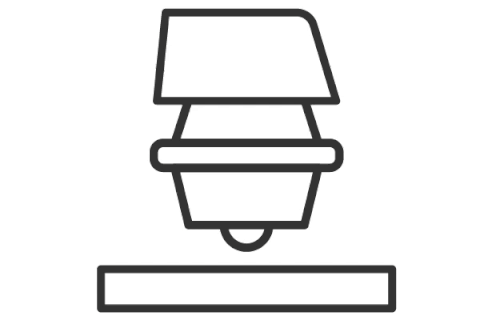
Wooting generally does a great job of living up to expectations, though. The keyboard is solid, well-built, and comes with a two-year warranty. If a switch breaks, you can swap it out, as the board is hot-swappable. That's one benefit of there not really being all that many mechanical moving parts with a magnetic Lekker switch, and another is that there's less to break in the first place.
That's what I've loved about every Wooting keyboard I've looked at so far, and no more so than the Wooting Two HE: they're not built on a great concept; they deliver it. Even if you think you're sold on the analog movement of the Wooting, and it can be limited in scope depending on your preferred games and genres, there are many other great reasons to love it beyond that.
Read our full Wooting Two HE review.
The best ergonomic gaming keyboard






Specifications
Reasons to buy
Reasons to avoid
✅ You want the best ergonomic gaming experience: You'll find more ergonomic keyboards, and more gaming ones too, but you'll not find a keyboard that blends the two worlds quite as well as this one.
❌ You're on a tight budget: Ergo boards aren't known for being cheap, and this gaming-specific one requires the extra $30 lift kit to unlock its full potential.
The Kinesis Freestyle Edge RGB has been specifically designed to blend the best of ergonomic and gaming keyboards, which is why it ranks as our pick for the best ergonomic gaming keyboard overall.
The most striking feature for the Kinesis has to be its split design. A single cable connects the two halves, and this offers you the freedom to shift it into a position that's more comfortable long-term. Best practice is to loosely keep both halves in front of your hands without having to turn in at all at the elbows. Not only is this good for your wrists but it's good for your arms and shoulders, too.
The split design does mean you need to be pretty comfortable typing with both hands across both halves. No problem for touch typists or anyone that glues their index fingers to F and J, but if you tend to stab from the centre it can take a bit of adjustment. Compared to some ergo boards this layout isn't too taxing at least.
The wrist rests are built into each half of the Freestyle Edge RGB, and they're plenty plush for long-term gaming or typing. Though if they're not to your liking, you can detach them and replace with something more your speed. What's a bit of a surprise is that the Kinesis doesn't come with a lift kit included in the box, it's sold separately. That means you're a bit more limited in adjustments you can make to the Kinesis compared to some ergo boards. Still, it does make up for it with some excellent gaming-specific features.
Cherry MX mechanical switches mean this ergo keyboard isn't a slouch for gaming, and of course there's fully adjustable RGB lighting on a per-key basis.
All in all, the Kinesis Freestyle Edge RGB is a seriously good ergonomic gaming keyboard, and one that shouldn't be glossed over even if you were originally thinking of a more standard layout.
Read our full Kinesis Freestyle Edge RGB review.
The best membrane gaming keyboard

10. Razer Cynosa Chroma
Our expert review:
Specifications
Reasons to buy
Reasons to avoid
✅ You're prone to spills: Membrane keyboards are naturally quite spill resistant. Though they will still get gunked up if you're not careful to clean them off as best you can.
❌ You want a tactile and speedy response: Membrane boards are nowhere near as lovely to use as mechanical in most users' opinions.
If even mecha-membrane keys don't suit you, and you demand a full membrane typing/gaming experience for whatever reason (no judgement here), the Razer Cynosa is the deck for you. I know there are people out there who prefer the soft embrace of a pure membrane switch, and that's fine—each to their own.
The Cynosa has some of the best feeling, low profile membrane keys I've ever tested, and at a retail price of $60/AU$89, it is one of the most affordable gaming keyboards out there (well, past a certain threshold of quality). While it may lack some of the features several gaming boards pack in, stuff like a dedicated wrist rest or media controls, it does boast Razer's extensive RGB lighting, which can be programmed on a per-key basis or applied by zones.
Compared to a lot of membrane boards out there, the Cynosa Chroma is still pretty barebones, but coming from Razer you can bet it's heaps cooler than those ones you used to type on at school.
It's a solid, no-frills, nice-looking keyboard that's the best membrane option of a huge range that I've tested. There is a step-up version of the Cynosa available. Still, for $20 extra, the only real addition is under-glow RGB, so unless that kind of 'ground effects' package is massively appealing to you, I recommend you save your cash and invest in the base model.
How we test gaming keyboards
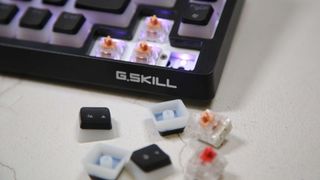
We've years of experience testing gaming keyboards on team. Each and every keyboard include in this guide has been reviewed by a professional. To do that, we use the keyboard extensively during the test period, inspect the switches, utilize the software, and use any special features the keyboard may have.
A big part of a keyboard's quality is how it feels to type on, and that comes down to the key switches. Are they sticky? Are they smooth? Do they feel like they're filled with sand? Have they been lubed? There are a lot of variables for just the key switches alone. We know what is best for gaming and typing, and what definitely isn't.
As for the keyboard, the layout can be a sticking point for some, as well as where the media keys are placed. Even the type face is a key point of contention for these boards, and we do judge them on every aspect to make sure we've picked the best for your money.
Also tested
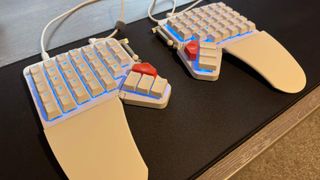
For a high price you can score a slick ergonomic keyboard with huge flexibility. It's not exactly a gaming keyboard, but for a long-term typist it's absolutely fantastic.
PC Gamer score: 89%
For
- Very comfortable in use
- Quick to setup
- Easy key remapping
- App is extra handy
Against
- Lengthy adaption period
- Very expensive
- Blanks keys are confusing at first
- No wireless option
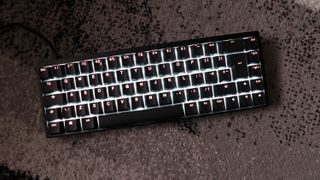
Endgame Gear’s first gaming keyboard is a real winner, especially for FPS titles.
PC Gamer score: 88%
For
- Incredibly powerful hall-effect switches
- Lightweight software
- Sturdy aluminium construction
Against
- It may look a little boring to some
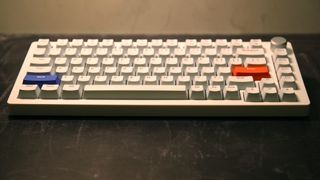
The typing experience delivered by the super-smooth Hall effect magnetic key switches is excellent, and the manual adjustments can make it incredibly responsive, too. But without a robust piece of software to accompany it you're never going to be able to make full use of its versatile switches. And that makes the DrunkDeer A75 feel like half a product right now.
PC Gamer score: 71%
For
- Great typing feel
- Super responsive
- Physical volume wheel
Against
- Dreadful software
- Missing functionality
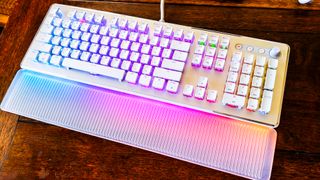
An absolute pleasure to look at, the Roccat Vulcan II Max is also a brilliantly responsive gaming keyboard with heaps of customization, though it comes at a high price.
PC Gamer score: 86%
For
- Drop dead gorgeous
- Dual-LED function is pretty and useful
- Highly sensitive optical switches
Against
- A little too much plastic at this price point
- Roccat Swarm software needs a revamp
- Requires two USB ports
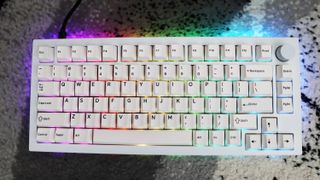
An awesome custom keyboard with an especially high price tag to match. The Sense75 is a marvellous board with great switches, gorgeous RGB and great construction, but only worth considering if you’ve got deep pockets.
PC Gamer score: 71%
For
- Sublime build quality
- Excellent typing experience
- Sumptuous RGB lighting
Against
- Sorry, how much is it again?
- Wait, it’s $399?
- Oh, and the case is a tad pingy
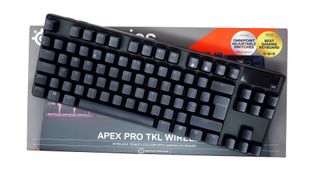
With nifty magnetic switches and simple profile switching, the SteelSeries Apex Pro TKL Wireless is a great gaming keyboard. But if you're after those smart features and don't care for the wireless connectivity, you can save yourself a lot of cash by grabbing the wired version.
For
- Simple profile switching
- Actually useful OLED screen
- Adjustable actuation
- Good battery life
- PBT keycaps
Against
- Wireless version is expensive
- Sleep mode is too aggressive out of the box
- Stiff competition
How to spot the best deal
Where are the best gaming keyboard deals?
In the US:
- Amazon - Savings on PC gaming peripherals
- Walmart - Still some good savings on Razer mice and keyboards
- Best Buy - Up to $105 off your next mechanical keyboard
- Target - Budget gaming keyboards up to $40 off
- Staples - Discounts on Microsoft ergonomic and gaming keyboards
- Drop - Save up to 35% on enthusiast keyboards
In the UK:
What is the big deal with mechanical switches?
We can talk for hours about the feel of mechanical switches versus membrane switches, but ultimately that's a personal choice. What makes mechanical switches objectively superior, however, is their far extended life span. They can take far more punishment and keep responding long after a membrane switch has collapsed in on itself.
Why do gamers use 60% keyboards?
The main reason gamers will use compact 60% keyboards is because the smaller form factor allows for more space for your gaming mouse. That means you can have to DPI levels in your mouse lower, offering greater accuracy but also necessitating wider sweeping movements.
It also means that your hands resting on the WSAD keys and the mouse are closer together, which in turn improves the ergonomic posture, either when gaming or simply using your computer.
What is the most important thing to look for in a mechanical gaming keyboard?
The switch type is arguably the most important choice to make when picking your new gaming keyboard. Cherry mechanical switches are the most common and most recognizable, but there are a host of alternatives on offer, as well a bunch of upmarket, specialist switches to choose from.
Are dedicated media controls a deal-breaker?
Only you can make that call, but we would suggest that at least having the option to toggle the top row between function and media controls would be our choice. Having a discrete volume wheel can be super useful, however.
What size of keyboard do I need?
Keyboard size is absolutely a defining factor. Full-sized keyboards tend to offer the most features and a Numpad, but if you don't have space, then all of those extras you paid for will be useless. Tenkeyless boards (the ones with no number pad) and compact keyboards can be a great option, too, if you don't care about all the extra bells and whistles or you don't have any use for alt codes (how barbaric!).
Jargon buster
Actuation Point
The height to which a key needs to be pressed before it actuates and sends an input signal to a device.
Clicky
A switch that delivers an audible click every time it's pressed, generally right around the point of actuation.
Debounce
A technique to ensure that only one input registers every time a key is pressed.
Housing
The shell that surrounds the internal components of a switch.
Hysteresis
The result of the actuation point and reset point in a switch being misaligned. This generally means a key needs to be lifted off further than normal before it can be actuated again.
Linear
A switch that moves directly up and down, generally delivering smooth keystrokes without noise or tactile feedback.
Mechanical Keyboard
A keyboard built around individual switches for each key rather than a membrane sheath mounted on a PCB.
Membrane Keyboard
A keyboard on which all the keycaps are mounted on a membrane sheath; when a key is pressed, a rubber dome depresses and pushes against the sheath and PCB beneath, actuating the key.
Stem
The component of a switch on which the keycaps are mounted on a mechanical keyboard.
Switch
The physical component of a mechanical keyboard beneath the keycaps on a mechanical keyboard. The switch determines how a key is actuated, whether or not it provides audible or tactile feedback with each press, and more.
Optical switch
This is a type of mechanical switch which instead of a physical metal contact switch uses light to measure when actuation takes place. These can be more configurable too, allowing for not just off and on states, but more analog designs, and even dual actions for a single key depending on how far the switch is pressed down.
Tactile
A switch that provides a 'bump' of feedback every time it's pushed.
Tenkeyless (TKL)
A keyboard that lacks the right-hand number pad.
Comic deals, prizes and latest news
Sign up to get the best content of the week, and great gaming deals, as picked by the editors.

Jacob earned his first byline writing for his own tech blog. From there, he graduated to professionally breaking things as hardware writer at PCGamesN, and would go on to run the team as hardware editor. Since then he's joined PC Gamer's top staff as senior hardware editor, where he spends his days reporting on the latest developments in the technology and gaming industries and testing the newest PC components.
- Alan Dexter
- Dave JamesManaging Editor, Hardware
- Reece Bithrey
Most Popular



